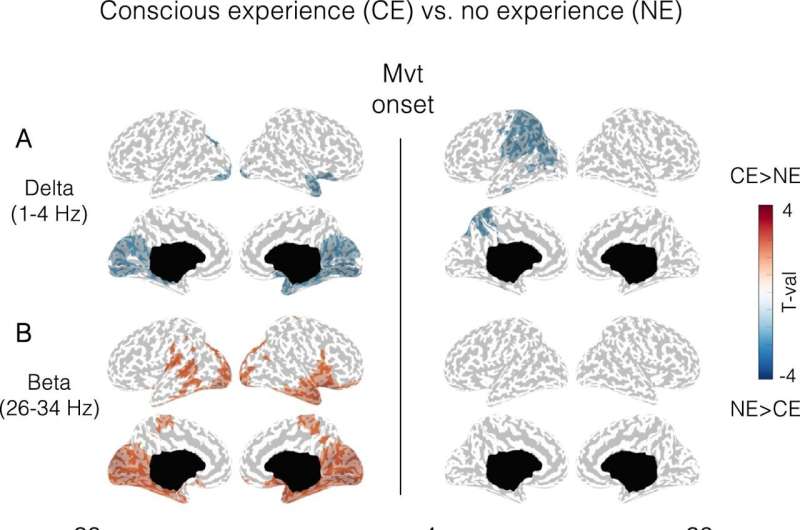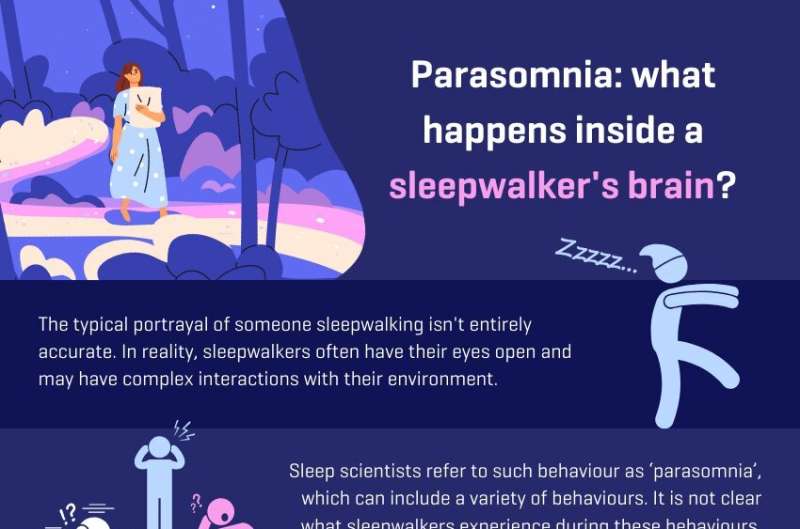This article has been reviewed according to Science X's editorial process and policies. Editors have highlighted the following attributes while ensuring the content's credibility:
fact-checked
peer-reviewed publication
proofread
Parasomnia: What happens inside a sleepwalker's brain?

Researchers at the Netherlands Institute for Neuroscience have taken a first step in exploring a rather complex question: what is happening inside the brain of somebody who may be considered "stuck" between sleep and wakefulness?
Most of us imagine a sleepwalker as someone who is unconsciously walking around while their eyes are closed and their arms are stretched out in front of them. In reality, sleepwalkers typically have their eyes open and may have complex interactions with their environment. Sleep scientists refer to such abnormal sleeping behavior as "parasomnia," which can include simple behaviors like sitting up in bed and seeming confused, but also more elaborated ones like getting out of bed and moving around or screaming with a fearful facial expression.
While parasomnias of this type are more common among children, approximately 2–3% of adults still experience them regularly. Parasomnias can be distressing to both the sleeper and the bedpartner. "Affected individuals can hurt themselves or others during episodes and may later feel deeply embarrassed for what they did," Francesca Siclari, head of the dreams lab, explains.
Parasomnia episodes in a lab setting
Siclari and her team have conducted this study to better understand what occurs in the brain during parasomnias. "It was commonly believed that dreams only occur in one sleep stage: REM sleep. We now know that dreams can happen in other phases too. Those who experience parasomnias during non-REM sleep sometimes report having dream-like experiences and sometimes appear completely unconscious (i.e., on automatic pilot)."
The study is published in the journal Nature Communications.
To understand what accounts for these differences in experience, Siclari and her team investigated the experiences and brain activity patterns of patients with parasomnia in non-REM sleep.
Measuring someone's brain activity during a parasomnia episode is no mean feat. The patient needs to fall asleep, experience an episode, and have their brain activity recorded while moving around.
"There are currently very few studies that have managed to overcome this. But with the many electrodes we use in the lab and some specific analysis techniques, we can now get a very clean signal, even when the patients move around," Siclari explains.
Siclari's team can provoke a parasomnia episode in the lab, but it requires two consecutive recordings. On the first recording, the patient sleeps normally. This is followed by a night in which the patient is kept awake is only allowed to sleep the next morning.
During this recording, the patient is exposed to a loud sound upon entering the deep-sleep stage. In some cases, this results in a parasomnia episode. After the episode, the patient is asked what had been going through their mind.

The brain during a parasomnia episode
In 56% of episodes, patients reported that they had been dreaming during the episode. "It was often about an impending misfortune or danger. Some reported that they thought the ceiling was going to come down. One patient thought they'd lost their baby and was searching through the bedsheets, and stood up in bed to try to save ladybugs from gliding down the wall and dying," Siclari explains.
"In 19% of the cases, the patients weren't experiencing anything and simply awoke to find themselves doing things, almost like a trance." Another small portion reported that they had experienced something but couldn't remember what it was.
Based on these three categories, Siclari's group compared the measured brain activities and found clear parallels. "Compared to patients who did not experience anything, patients who dreamt during the episode showed activations that were similar to brain activations previously found for dreaming, both immediately before the episode, and also during the episode," adds Siclari.
"What determines whether the patient will be completely unconscious or will instead dream seems to depend on the state the patient is in at that moment. If we activate the brain while they're likely already dreaming, they appear to be able to 'make something' of the activation, while when their brain is largely 'inactivated,' simple behaviors seem to occur without experience.
"Interestingly, patients almost never mention the sound that initiated the parasomnia episode, but rather some other type of impending danger. The louder we go with the sound volume, the higher the chance that we provoke an episode."
The next steps
Because this is only the first step, there is a lot of room for follow-up studies. "Ideally, we'd like to set up a system for more people to record their sleep at home, where they may also have much complex and more frequent episodes. We'd also like to repeat the same type to studies in people who experience parasomnias in REM-sleep. By measuring brain activity like in this study, we hope to eventually better understand which neural systems are involved in different types of parasomnias," says Siclari.
While there is still a lot of research to be done, Siclari is confident that her work can provide valuable insights. "These experiences are very real to the patients and most already felt relieved to be sharing them with us. Similar to previous studies, our research clarifies what they are experiencing, which is educationally valuable.
"Additionally, our work could contribute to more specific drug interventions in the future. Parasomnias are often treated with unspecific sleeping drugs, which isn't always effective and can have negative side effects. If we can deduce which neural system is working abnormally, we can eventually try to develop more specific treatments."
More information: Jacinthe Cataldi et al, Shared EEG correlates between non-REM parasomnia experiences and dreams, Nature Communications (2024). DOI: 10.1038/s41467-024-48337-7





















